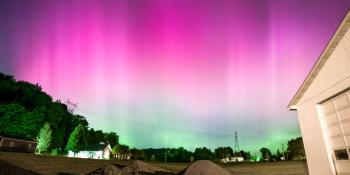Viendo archivo del jueves, 3 junio 2004
Informe actividad solar
Any mentioned solar flare in this report has a scaling factor applied by the Space Weather Prediction Center (SWPC). Because of the SWPC scaling factor, solar flares are reported as 42% smaller than for the science quality data. The scaling factor has been removed from our archived solar flare data to reflect the true physical units.
Informe de actividad Solar-Geofísica 2004 Jun 03 2200 UTCPreparado por NOAA © SWPC y procesado por SpaceWeatherLive.com
Informe conjunto USAF/NOAA de actividad Solar y Geofísica
SDF Número 155 Publicado el 2200Z a las 03 Jun 2004IA. Análisis de regiones solares activas y de actividad desde 02-2100Z hasta 03-2100Z Solar activity continues at very low levels. Region 621
(S14W01) contains minor magnetic mixing, but produced only small
B-class activity. This period was actually highlighted by a number
of CMEs, predominately off the west limb. The first of these
occurred at around 02/2300Z from behind the northwest limb. An
associated Type II radio sweep was observed with a shock speed of
658 km/s. Bright surging was observed on the west limb at 0830Z,
which preceded another CME observed on LASCO imagery at 0950Z. The
most impressive event of the period was a partial halo CME
associated with a prominence eruption that began at around 03/1620Z.
A Type II radio sweep (717 km/s) accompanied this CME. Much of the
ejecta associated with this CME appeared to originate from behind
the northwest limb.
IB. Pronóstico de la actividad solar
Solar activity is expected to be very
low to low. Very low levels are expected through 4 June. C-class
activity is possible on 5 and 6 June with the return of old active
regions.
IIA. Resumen de la actividad geofísica 02-2100Z a 03-2100Z
The geomagnetic field was quiet to unsettled. Solar wind speed
remains elevated near 500 km/s, but IMF Bz was predominantly
northward. The greater than 2 MeV electron flux at geosynchronous
orbit reached high levels today.
IIB. Pronóstico de la actividad geofísica
The geomagnetic field is
expected to continue at quiet to unsettled levels. There is a chance
for isolated active periods at high latitudes through 4 June. The
current weak coronal hole high speed stream is expected to subside
by 5 June.
III. Probabilidades del evento 04 Jun a 06 Jun
| Clase M | 05% | 10% | 10% |
| Clase X | 01% | 01% | 01% |
| Protón | 01% | 01% | 01% |
| PCAF | green | ||
IV. Penticton 10.7cm flujo
Observado 03 Jun 090 Previsto 04 Jun-06 Jun 090/095/095 Media de 90 Días 03 Jun 104
V. Índices Geomagnéticos A
Observado Afr/Ap 02 Jun 009/011 Estimado Afr/Ap 03 Jun 009/012 Previsto Afr/Ap 04 Jun-06 Jun 008/010-005/008-005/008
VI. Probabilidades de Actividad Geomagnética 04 Jun a 06 Jun
| A. Latitudes Medias | |||
|---|---|---|---|
| Activo | 25% | 15% | 15% |
| Tormenta Menor | 05% | 01% | 01% |
| Tormenta Mayor-Severa | 01% | 01% | 01% |
| B. Latitudes Altas | |||
|---|---|---|---|
| Activo | 30% | 20% | 20% |
| Tormenta Menor | 10% | 05% | 05% |
| Tormenta Mayor-Severa | 05% | 01% | 01% |
All times in UTC
< < Ir a la visión general diaria
Últimas noticias
Últimos mensajes del foro
May 2024 Geomagnetic Storms from AR 13664 (2) 317What makes AR3684 magnetically distinct from AR3685? 3Unproven theories 482"It Was Fake, It Was HAARP" - What? 7Don't we need better high geomagnetic parameters? 7
Más temasApoye a SpaceWeatherLive.com!
Mucha gente viene a SpaceWeatherLive para seguir la actividad del Sol o previsión de aurora, pero con esta cantidad de tráfico se incrementan los costos del servidor. ¡Considere hacer una donación si disfruta de SpaceWeatherLive para que podamos mantener el sitio web en línea!

Hechos clima espacial
| Último evento clase X | 2024/05/15 | X2.9 |
| Último evento clase M | 2024/05/17 | M7.1 |
| Últimas tormentas geomagnéticas | 2024/05/17 | Kp6 (G2) |
| Días sin manchas | |
|---|---|
| Último día sin manchas | 2022/06/08 |
| Promedio de manchas solares mensuales | |
|---|---|
| abril 2024 | 136.5 +31.6 |
| mayo 2024 | 157.2 +20.7 |
| Last 30 days | 174.3 +64.2 |


